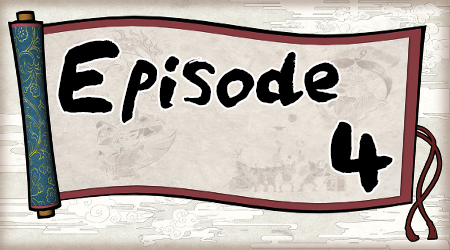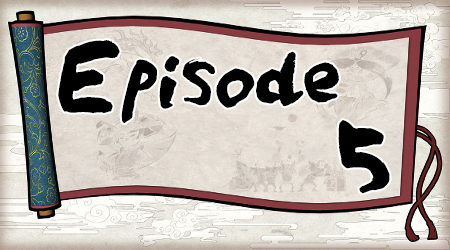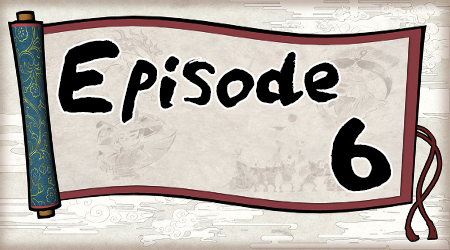|
I missed the other LPs, so I'm glad you're playing through this one! A couple things from episode 2: Issun mentions the River of the Heavens in the video. The name in Japanese is 天の川 (あまのがわ, ama no gawa) , which you can see written on a stone. "River of the Heavens" is a pretty literal translation, but this is also the Japanese name for the Milky Way! And of course, it features in Japanese mythology. One such feature is in the tale of two deities Orihime and Hikoboshi. These lovers are separated by the Milky Way, but can reunite once a year. Their reunion is commemorated by the Tanabata festival in Japan. The Japanese names of the gods use kanji characters that match their functions, and the kanji that appears when they give you their power is the first of their name.
You also mentioned the word play for "wolf" and "god". In Japanese, the game is called 大神 (おおかみ, ookami), which is an archaic term for the "god". The word 狼, or "wolf", has the same pronunciation, which, well, that's the game right there. Japan has a lot of word play, in no small part due to a large amount of homophones. Anaxite fucked around with this message at 02:36 on Feb 11, 2017 |
|
|
|

|
| # ¿ May 3, 2024 01:16 |
|
There's a bunch of neat stuff in episode 3, and that's not even going into the mythology! Here's some of what I noted: The icons that appear above the petrified villagers' heads look like Jizō statues... Those statues represent a buddhist divinity that's widely believed to be the guardian of children, in particular those who died before their parents. The divinity is also believed to watch over travelers. You can find these statues in many places in japan, with bibs or children's clothing put on as offerings. However, there are a lot of buddhist statues in Japan, so it's possible I mixed something up and that's some other statue that looks similar. Still, look at them:    When you draw the sun in the sky, it shows the kanji character 照, which means "illuminate". Not only that, it's part of Amaterasu's name in Japanese: 天照 (which is not her full name)! Gaining praise shows the kanji character 幸, which means any of "happiness, blessing, fortune". 8:35 - The traveler's charm is basically a charm that you can get at Shinto shrines or Buddhist temples in Japan. Seriously, they're everywhere, and will cost you anywhere from $5 to  . They're meant to be burned/discarded at the lunar new year if you want to be super picky about it. . They're meant to be burned/discarded at the lunar new year if you want to be super picky about it. 9:29 - Some of the villagers have a weird face as their conversation icon. Those are henohenomoheji, and I'll let Wikipedia explain: Wikipedia posted:Henohenomoheji (へのへのもへじ) or hehenonomoheji (へへののもへじ) is a face drawn by Japanese schoolchildren using hiragana characters. The blue sake bottle you give to Susano has, unsurprisingly, the kanji character for "alcohol" written on it: 酒. Susano's house has a scroll in the back, but that handwriting is way beyond my abilities. If someone has a bigger view, it might be decipherable. 26:55 - The merchant's shop has the characters for North, South, East, and West written on the cloth in the back, in their respective positions:
Finally, we've now been in a quite a few fights since last episode. You probably noticed that the walls of the arena are covered in kanji characters. It's hard to see all of them, but you can make out quite a few in the inner barrier such as:
Anaxite fucked around with this message at 02:55 on Feb 11, 2017 |
|
|
|
Ryushikaze posted:His penmanship is TERRIBLE, but from memory, it's his family name. That's a cool detail. It's frustrating that nothing I'm finding references it! 
|
|
|
|
poorlywrittennovel posted:Anaxite your posts are super cool, is it okay for me to quote them in the relevant updates for future archival purposes? Sure, I was also thinking of doing a brief overview of Japanese deities based on their namesakes, but that might take a bit if I do it! Anaxite fucked around with this message at 02:59 on Feb 11, 2017 |
|
|
|
poorlywrittennovel posted:
Writing and culture notes for episode 4: The cords around trees and objects are a Shinto tradition. I'll let Wikipedia explain this again: Wikipedia posted:Shimenawa (標縄・注連縄・七五三縄, "enclosing rope") are lengths of laid rice straw or hemp rope used for ritual purification in the Shinto religion. They can vary in diameter from a few centimetres to several metres, and are often seen festooned with zigzag-shaped paper streamers. A space bound by shimenawa often indicates a sacred or pure space, such as that of a Shinto shrine.  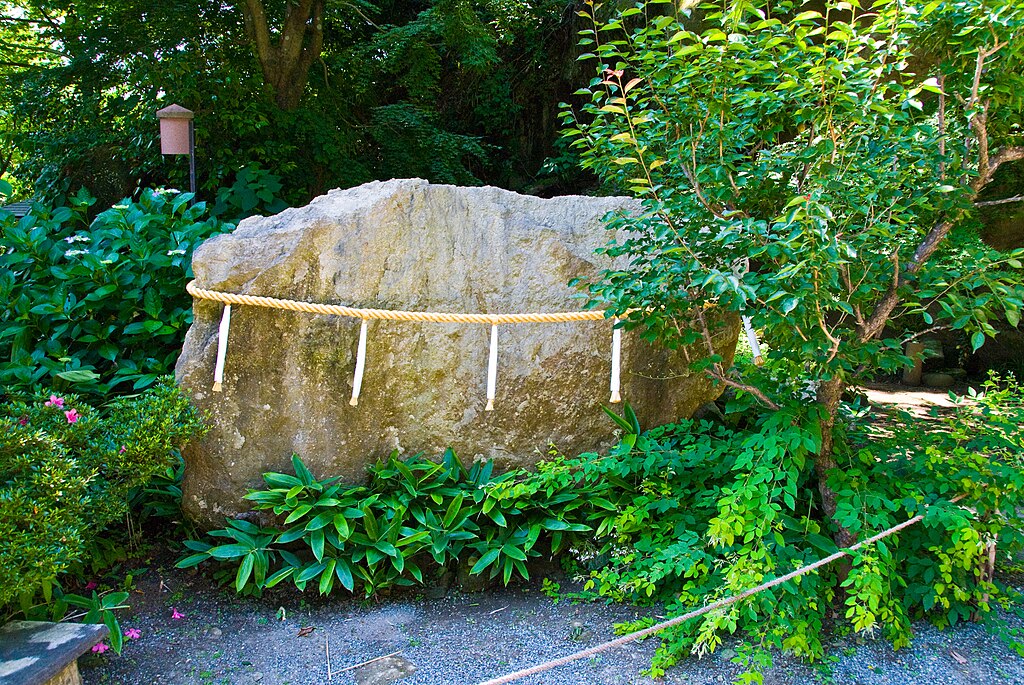 So yeah, all those in-game trees are holy or linked to spirits. Animism! --- 7:30 - A leaf on an animal's head is a pretty good indicator that it's some sort of magical creature. This may come from stories of tanuki that transform, and find it easier to do so if they place a leaf on their heads (so in a way, everything with a leaf may be a tanuki... according to some stories). 8:19 - The four kanji characters that appear, 素狭悩汚, can indeed spell out su-sa-no-o, but, uh... that arrangement is a bit unorthodox. The kanji roughly mean: plain - narrow - trouble - dirty. Sounds familiar? New god names:
15:18 - Hey, those are some of the Jizo statues I was talking about! They're like some you'd find in real life. --- By now, you may also have noticed the symbols written on the enemies' heads. Those are katakana, characters from one of the two Japanese syllabaries. At first I didn't know why they were there, but I learned that it's a power level indicator based on the iroha. The iroha is an old Japanese poem which was composed around the Heian area; its first proof of existence was around 1079. The iroha is special for using each of the Japanese syllables only once so, among other uses, people have used it as an alternate method of ordering syllables (much like we order the alphabet). We've now seen the first three power levels, fittingly イ (i), ロ (ro), and ハ (ha). Based on the poem, this is the order of enemies' power levels: quote:イ ロ ハ ニ ホ ヘ ト Anaxite fucked around with this message at 21:11 on Feb 11, 2017 |
|
|
|
Cool. I never watched further into the game, so I look forward to it. I also found out that there's more symbolism with the monkeys and instruments, but I'll wait until we see all three to point it out. If I remember. e: Also it looks like when I quoted wikipedia, it broke quoting me. I'll send you my raw posts!
|
|
|
|
Mak0rz posted:And then there's Meoto Iwa, the Married Couple Rocks, that has a two thousand pound rope connecting them that is ceremoniously replaced many times a year. And I thought rebuilding the Ise grand shrine everyone 20 years was hard work! That's dedication. Chimera-gui posted:Pretty sure that's supposed to be a demonic screech, any sound effects in the background are meant to be the noises of demons. They may be going for that effect, though there's also a technique of using vocalizations to communicate rhythm and stuff to other performers. You can see it in a noh play, for example. Pay attention to the people in the background: https://www.youtube.com/watch?v=1hI8edPXNS0&t=2580s Anaxite fucked around with this message at 23:23 on Feb 11, 2017 |
|
|
|
Writing and culture notes for episode 5: 05:10 The gates you enter to fight demons have this written on them: 羅城門 - Rajōmon. The Rajōmon, also called Rashōmon due to some plays, was a gate from the ancient Japanese cities of Heijō-kyō (Nara) and Heian-kyō (Kyoto). There was one in each city; it was built at the southern end of the central avenue leading to the Imperial Palace from the south, laid out according to Chinese grid patterns. The characters just mean "main city gate", and I'm wondering if that texture was even readable in the PS2/Wii versions. For more info, you can read on Wikipedia, or if you're feeling lucky, in Japanese on the Kyoto city website. 10:39 The sign on the dojo reads 色即是空. It means "Matter is void/All is vanity." 11:19 Your Jolly Dougnut-san comment is apt, since his name is literally Teacher Rice Ball!  I want one bad. 12:39 This is just something that feels weird to me after being in Japan. I know tatami mats are soft enough you'd prefer to use them when you do things that involve hitting the floor, but... still! Tatami are things you actually need to care for a bit, so why wouldn't you train on, say, wood? And why would you let the dog on them after just coming from outside? What the hell, teacher? (This peeve comes from having to remove shoes and indoor-only slippers to get on tatami mats inside bedrooms. Yes, I know it would be different in a dojo) 15:51 Demon purification or exorcism arrows are a thing. You can even buy amulets or charms in shape of arrows, though they're more costly than the small portable charms shown earlier. Here's one ritual ceremony in Japan that uses arrows to symbolize purification: https://www.youtube.com/watch?v=-JYUpCVkSJg 16:00 Why do so many demons come with bells? Good question. That may be a stylistic choice, borrowing from Shinto and Buddhism; bells do feature in both those belief systems, and demon monks are not unheard of in stories. 17:56 Your new enemy is named 骸金魚 (むくろきんぎょ, mukurokingyo), so "corpse goldfish". 19:23 On the diagram, at the top left, you can see that Tama wrote 花火玉 (はなびだま, hanabidama?). It just means "firework ball", so a cherry bomb. If you spoke Japanese it might be one more clue to tie to the symbol. New god name:
AlphaKretin posted:Oh, hey. Not to tread on Anaxite's toes, but Tama's firework showed patterns of a Boar, Deer and Butterfly. Either that's a reference to the Inoshikacho yaku in Koi-Koi/Hanafuda, or they're both references to something mythological. I'd have confirmed which via Google if I didn't just get results about Naruto. That's cool! I was wondering the significance and you delivered. For others, Ino-Shika-Cho is a 5-point scoring combination of hanafuda cards, in the Japanese card game Koi-Koi, featuring animals as AlphaKretin says: A boar (猪, いのしし, inoshishi), a deer (鹿, しか, shika), and a butterfly (蝶, ちょう, chō). You can see an example here. Anaxite fucked around with this message at 06:07 on Feb 15, 2017 |
|
|
|
Mr. Vile posted:Also, Master Onigiri is a double edged pun in that it can be read as either "rice ball" (o-nigiri) or "demon slash" (oni-giri) I'm sad I didn't get that one.
|
|
|
|
poorlywrittennovel posted:
Thankfully we've seen a lot of stuff by now, so my notes for episode 6 are shorter. New god names:
26:33 - The Japanese name for Waka is shown as Ushiwaka (ウシワカ).
|
|
|
|
Do you like art? I like art! Strap in, because I think it's time to look at Disclaimer: I'm not a professional game designer. These are my observations based on past modding, knowledge of various technology, and a whole lot of guessing. ---- First, let's think back to 2005-2006. About five years after the release of the PS2, the PS3 and Okami are both unveiled at E3 2005. By now, PS2 development has matured enough for games to show much improved visual fidelity, but also to really hit hardware limits. The PS2 has a particular kind of processor architecture which made development a bit harder in some circumstances. Also, even if you could harness the advantages of this architecture, it didn't change that you always have memory or CPU limitations... and the PS2 is still a ~300 MHz machine with 32 MB of system memory, and 4 MB of video memory. The PS2 also doesn't support nifty features we now take for granted like normal maps or pixel shaders, which let you do things like add relief effect to textures, or modify the visual output on a per-pixel basis, respectively. It's not that those features couldn't be implemented on the PS2 (or on a SNES if you really want), but there was no hardware dedicated to speeding up those effects. If you wanted to have those kinds of features, you needed to create the effect in your graphics engine yourself, run it on a CPU not optimized for the task, and hope you don't need more memory to hold it. In short, you could have a bag of tricks for your PS2, but it was your job to make them, and hope they work. The PS3 could do better effects, being a full generation ahead and having a better GPU, but Okami wasn't made for it. Clover Studios was pretty clever, though. I think they had a good grasp of what makes painting or drawing styles iconic, and found five significant ways (as I see them) to implement relatively simple effects that worked with their vision. In no particular order, those are:
 Black bordering is probably the most prominent effect of the game, and has been staring at us since the beginning. Just look at this screenshot: 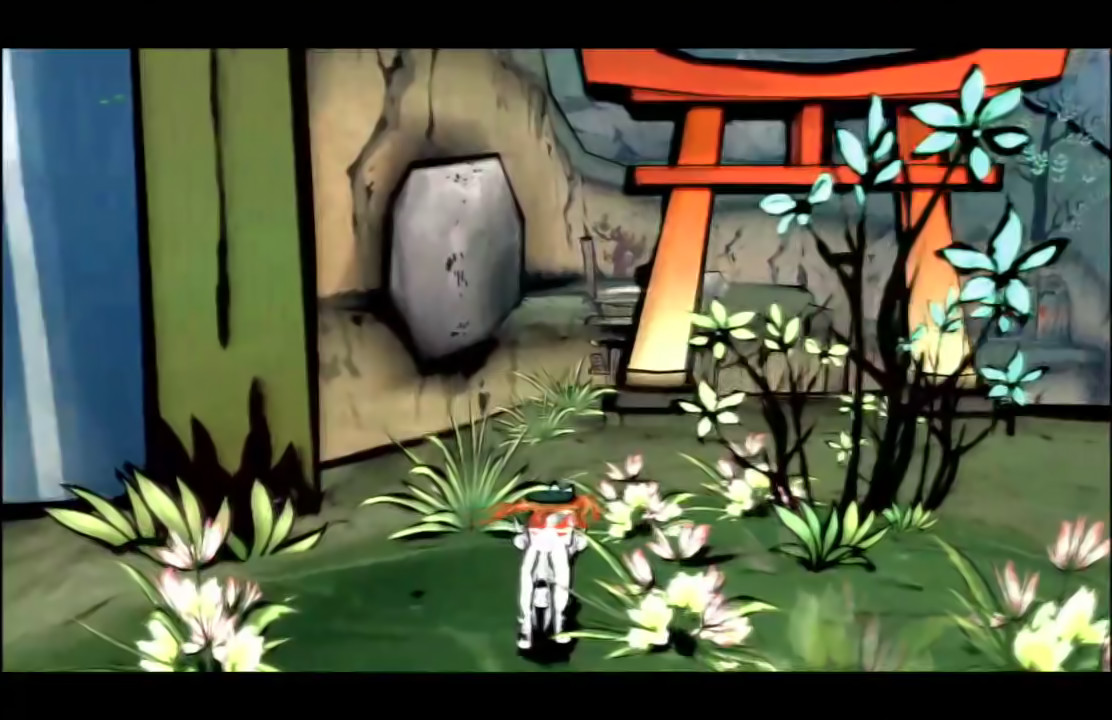 Almost every object in that image has a black border of some kind, like someone drew outlines with a brush. Not all bordering is created equal, though. In this section, I specifically mean black borders around 3D objects. Remember this sequence from Episode 6? Having gained the power to make water lilies, Amaterasu runs around a big tree on an island. The tree has a big black border. As we run around it, though, this border has some weird visual artifacting where its bottom seems to shrink and disappear.  You see that? That looks like a disappearing polygon, which tells us it's just another 3d object around the tree! When we see the black, we're actually seeing the inside of the 3d model. The see-through effect is due to how polygon visibility works. Polygons in 3d models have two sides. When you create a 3d model, and texture its surface, you can set which, or both, of the sides are textured; if you only do one, the other side becomes transparent. A lot of modeling software defaults to texturing the outside of 3d models, meaning that if the viewport camera somehow got inside or near the object, you'd suddenly be able to see through it. That's how you get moments like these: 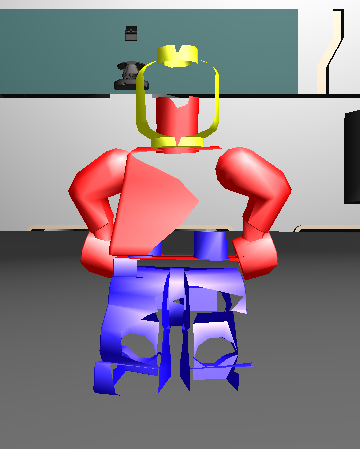 (courtesy Unity forums) (courtesy Unity forums)What Okami devs did with the tree relies on this texturing behavior. They made an exterior model with its inside polygons colored a flat black, and left the outside surface uncolored. When we're viewing the tree head-on, we're mostly viewing the outside of the border model, so it's invisible and doesn't obscure the tree. At the edges of the tree, though, we see through to the interior polygons of the rear half of the border model, so the tree gets a black outline... except towards the bottom, where the limitations of 3d models come into play. That's where we see individual polygon edges as the visible sides turn away from the camera. All black borders around 3d objects seem to be done the same way. A 3d model is cloned. The clone is enlarged, but remains linked to the original for position and animations. The clone's color is set to flat black, and the polygons have their texture face reversed. If you look closely at characters' and other 3d objects' outlines, you'll see similar visual artifacts as with the tree. Advantages:
The disadvantages are sufficiently minor to make any trade-offs worth it. Good shading effects can really tax a computer.  Sprites are two-dimensional bitmaps that are composited on a larger scene. We see the term used heavily when talking about 2d games, as foreground objects in those games are all sprites, animated or not. They're used in 3d games as well, but when they are, they have a unique property that they always look like they're facing the player -- 2d animations aside. Remember DOOM, Duke Nukem, or Wolfenstein 3D? Back then, we didn't have good 3d. In those games, almost everything which is not terrain is a sprite. These always face the camera no matter where they are, and the only calculations done are positioning, sizing, and obscuring things behind them. Look at the barrel:  Computers have done image compositing for a long time; it's not especially hard to do. Compare that to 3d models where on every frame, you need to also figure out what polygons are visible to the player, what textures and texture effects they use, how the lighting is done, how the polygons deform, etc... it gets complicated real fast. Since a sprite is a 2d image, it also doesn't use much more memory than a texture, rather than also needing the memory of a complex 3d model. Unfortunately, if you get too close to a sprite in a 3d game, it can look like poo poo. 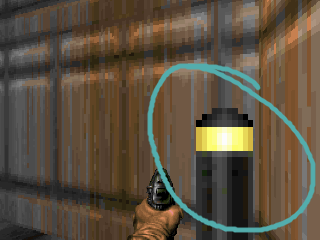 Okami uses sprites heavily. Those black trees you make bloom are sprites. The grass is made of sprites. The plants that trail behind your movement are sprites. All the cherry blossoms are made of sprites. 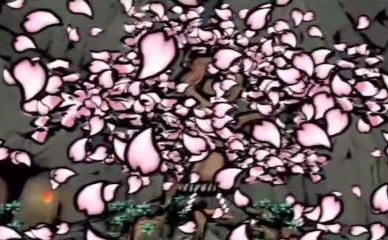 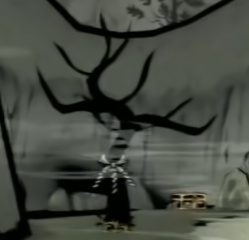 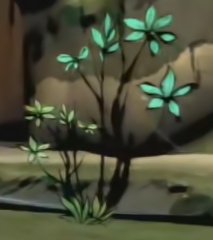 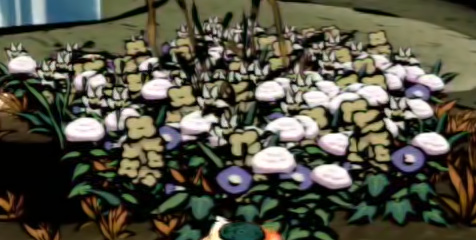 I believe sprites work in this game's favor for a few reasons. First, the sprites aren't too complex detail-wise, and smooth resizing is available. Second, the sprites are displayed alongside other 3d objects, somewhat hiding their 2d characteristics. Third, viewing flat images fits the aesthetic -- you always look at a painting head-on, and this game kind of pretends it's a painting. Finally, sprites are fairly light on the CPU, so a PS2 would chug along just fine. In order to save on image storage, many sprites are just copies of each-other. There's enough visual variety elsewhere to afford re-use, and the lesser resolution of the PS2 may have helped hide this copying. Still, the game looks great on the PS3 too! Advantages:
If this weren't a game with a painterly aesthetic, sprites probably wouldn't work so well. But it is, so they do, to a point.  By "texture", I mean the colored texture of 3d objects. Like this: 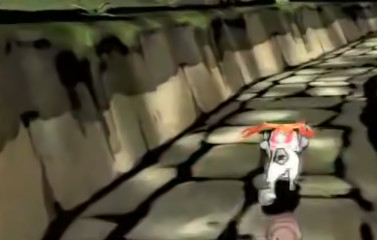 Okami uses a variably painted style for textures, though I think this is the least effective style point of the game. You could change the textures to some other look, like cel shading, and the other major effects could still shrine through. If you removed the other effects, though, I think the painted texture look would stop being as interesting. The textures complement but don't stand as well on their own. Still... it's good that the textures are as they are, and Clover also put in a bunch of neat effects. Look at Amaterasu's body and weapon: 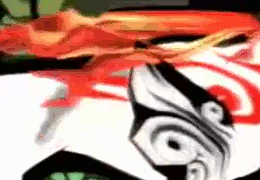 That pulsing is neat. I don't recall seeing it in many other places, or maybe it's just that Amaterasu is always in view and easier to notice. Clover may have done it by having an animated texture, though that would mean saving multiple textures as frames, thus using up more memory. They may also have done it by shifting the colors of textures in real-time, saving memory at the expense of using the CPU a bit more. If someone has other thoughts on how the effect is achieved, please let me know. I suspect we don't see many more complicated texture effects because they're not really necessary for the game's style, they would increase CPU usage, and implementing fancy shading effects for the PS2 means more development time. There are also two occasions I noticed textures used to great effect: gusts of wind, and Amaterasu's shadow. With wind, it looks like there are a bunch of simple 3d models in the sky. The telltale sign is that the wind is angular in places, suggesting 3d vertices. If that's the case, it uses a brushstroke texture which seems to animate by advancing along the model. Not having a sprite means a more dynamic view based on the camear, but still looking 2d and painted thanks to the simple brush texture: 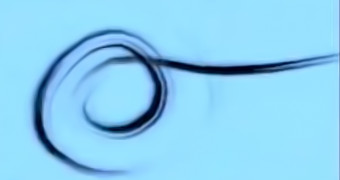 And with Amaterasu's shadow, there's nothing more than a brushstroke, which is far simpler than real-time shadow calculation. Hooray for thematic appropriateness! 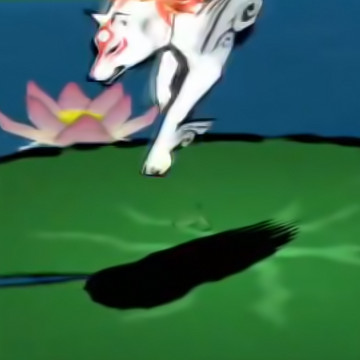 Advantages:
 This effect is easier to explain. Many 3d models and textures in the game can have, in whole or in part, exaggerated features. This is mostly visible on characters. 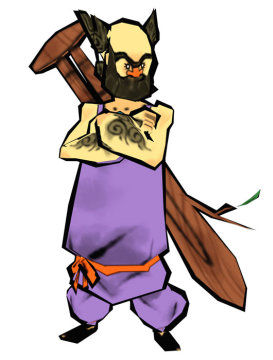  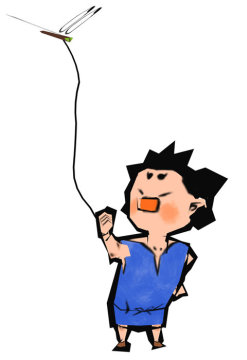  See? Susano has big arms and an unkempt, bushy beard. Kushi is svelte but has big flowing robes. Mushi has a big nose. Mr Orange has a big pendant, beard, and head. This is stuff done in cartoons and comics every day: emphasize the parts of the body which you want to draw attention to, and which reveal a character's personality. Disney had this idea a long time ago: 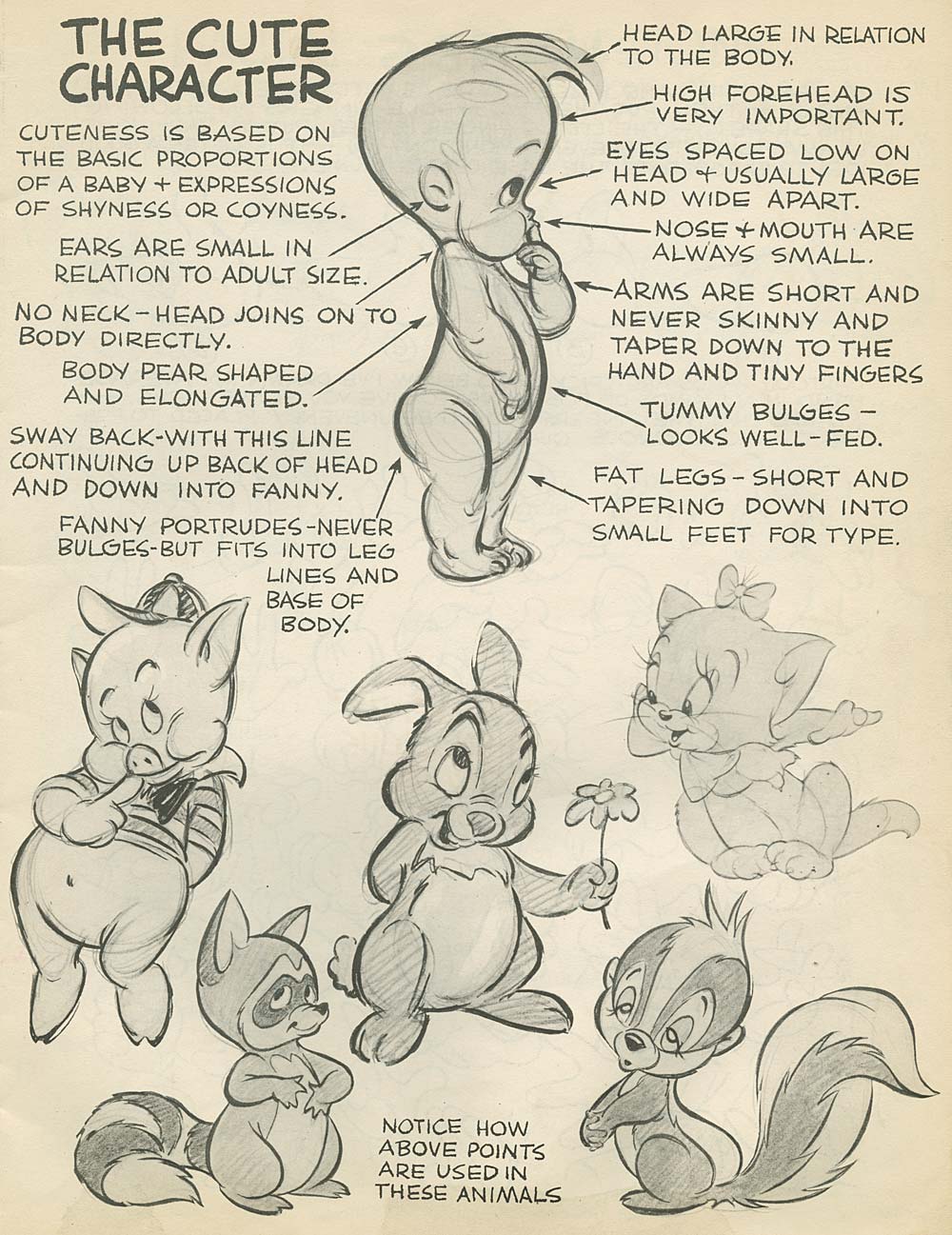 (Disney has more than just "cute" guidelines, if you go look for them) I'm not exploring animation as much, but you may be interested in how models deform. Squash and Stretch are important principles of animation, which we see to some extent in the game, such as when NPCs talk. If you want to know more, this video is pretty good: https://www.youtube.com/watch?v=HYP7rJni1vc Okami also features exaggerated 3d models such as huge shrine gates, or white cords around objects. If we're embracing a painting style, then we can eschew realism here too! I think this can be used to draw the player's focus for gameplay reasons, but object dimensions are a part of style, and we also need to make sure there's enough space for brush strokes on textures. Advantages:
 The final effect I'm exploring is one I think only applies to characters. If you look at Amaterasu when she's standing still, you can see that both her main 3d model and its bordel model seem to warp and deform independently: 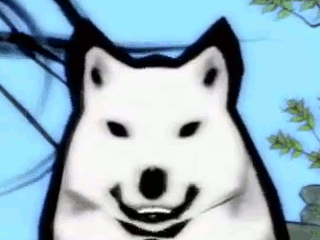 This effect is also applied to all other character models, and mimics hand-drawn 2d animation frames. You can imagine an artist sketching every frame of a character by hand, and none of their features turn out exactly the same. It's easy to find examples as video: https://www.youtube.com/watch?v=xYmxAfsvINA&t=10s or in video games (note the rough color look of the sprites): https://www.youtube.com/watch?v=-aO6VFuUVrg&t=85s I think the effect is achieved by randomly moving all the vertices of character models and border models, on every frame in real-time, within certain bounds. It's also possible to use a pixel shader for something like this, but that would probably be more costly in terms of CPU and memory usage on the PS2. Model deformation may be one of the more costly effects already. Either way, it looks good, and thankfully it's not overused. Can you imagine everything on the screen deforming? That would just give us headaches. Thankfully Clover didn't apply the effect to everything so, like in 2d animation, we have a clear separation between "animated" and "background". Advantages:
--- To summarize
I'm aware there are a couple more visual effects, but they don't seem as important to the aesthetic of the game as these five, to me. Anaxite fucked around with this message at 00:34 on Feb 21, 2017 |
|
|
|
Fedule posted:I have completed my analysis and determined that video games are fascinating. I'd love to know how Wind Waker fall under that category! It looks great, though I don't know much beyond "it has cel shading and lacks long loading times". poorlywrittennovel posted:Yo this is a really solid post on a lot of things I love about how this game achieves it's art style. I never even thought about how the outline effect was done before. I didn't either until you posted the last video and I saw Ammy run around the tree. Then something clicked and I couldn't unsee it.
|
|
|
|
Fedule posted:
Holy poo poo.
|
|
|
|
Mak0rz posted:So that black border thing is distinct from actual cel shading used in Wind Waker, Sly Cooper, Dark Cloud 2, etc? It's possible that one of those games renders 3d outlines in the same way, but I think rendering similarities stop there. Wind Waker doesn't even seem to use borders on 3d models, instead opting for the flat shading part only? Still, the intent is similar: recreating a style found in a 2d physical medium. Anaxite fucked around with this message at 07:09 on Feb 21, 2017 |
|
|
|
Josuke Higashikata posted:This game isn't flawless, but it is perfect. Okami is one of my favourite games bar none. If you've never played or experienced it, enjoy the ride. Thanks, I like the insight that this article gives on the upscaling technology. Expanding for those who didn't read: Okami on PS3 has two big things done for the PS3 version. One is the resolution; like said, the version renders internally at 3840x2160 then halves the resolutions. It's a crude way to do antialiasing, but if the system can handle it, it works well. The other thing is what they call Super Resolution. That's a technique of upscaling (or reconstructing) images from smaller ones by prediction. You resize a single image with various algorithms, comparing the end results' differences to guess what pixels are significant after resize. It's not ever gonna be perfect but seems to work well here. However, I don't think the article says whether the game does it on the fly or whether it was done ahead of time. Probably the latter. Zanzibar Ham posted:Anyone got ideas? E: You could post a screenshot, but it might be better to ask in the Dolphin community. Anaxite fucked around with this message at 20:10 on Feb 21, 2017 |
|
|
|
Hey poorlywrittennovel, everything okay?
|
|
|
|
Hooray, Zelda didn't kill this! --- 7:44 - The big statue looks like a Dogū (土偶) - small humanoid and animal figurines made during the late Jōmon period (14,000–400 BC) of prehistoric Japan. 13:09 - Our new enemy is named... the physalis! Or the husk tomato, ground cherry, Chinese lantern plant, etc. They look really cool when they're dry, and you may notice we've seen some around the level already:  (Thanks wikipedia!) (Thanks wikipedia!)There are a couple variations on the Japanese word for physalis, but the typical one appears to be 酸漿 (ほおずき/hōzuki). However, the enemy name is an alternate form written as 鬼灯. It has the same pronunciation, but the alternate characters roughly mean "ghost/devil lantern". But we're still fighting giant fruits, or Bulbasaurs. Take your pick. 18:38 - Those do look like haniwa. Terracotta clay figures for burial use. 30:17 - New god name:
36:05 - The checkpoint gate has the character 続 written on it. Unsurprisingly, it means "continue". 38:29 - The Japanese name for the boss monster is 女郎蜘蛛 (じょろうぐも/jorōgumo), which is a kind of orb-weaving spider. 女郎 is apparently also a term for a prostitute, so there's some interesting etymology. 44:18 - The cutscene scrolls not only show the story, they label the various elements. You can see Amaterasu's name, as well as Issun's full name - Issun-bōshi (一寸法師). It's been visible on other screens too. I'm not gonna transcribe the other stuff unless someone's super curious. 50:30 - Kiba is a fang trader. Kiba (牙) means fang. Yep. 1:11:11- 
|
|
|
|

|
| # ¿ May 3, 2024 01:16 |
|
Chimera-gui posted:Ah yes the Jorōgumo, a yōkai that I've actually talked about before in another LP thread where the woman spider was a boss in the game so I'll just let my past self explain for me: That's pretty cool, and seems completely in line with a lot of Japanese norms and monster origin stories.
|
|
|




